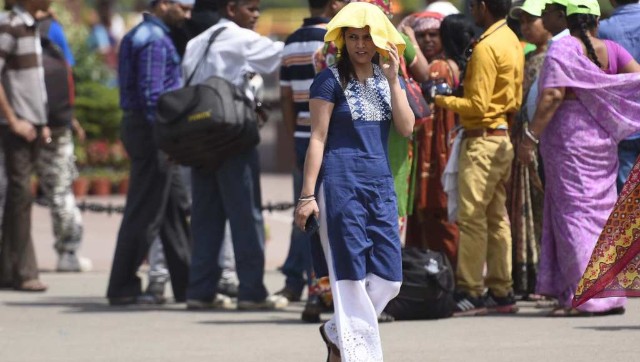Winter 2021-22 was one the wettest and coldest seasons in north India. After a prolonged winter chill, people expected March to be relatively pleasant. Instead, the month saw a sudden arrival of summer and unseasonal heatwaves all over India, at least a month before the schedule. Under the influence of unseasonal heatwaves, many decadal and some all-time records (ATR) have been broken in the western Himalayas and in the plains of Punjab, Haryana, Delhi, Rajasthan and Uttar Pradesh. Temperature remained 3-8°C above normal throughout the month, and in some stations it was reported as high as 10-15°C above normal. Areas in Rajasthan, Haryana, Delhi, Uttar Pradesh, Jharkhand, Chhattisgarh, Gujarat, Maharashtra, Madhya Pradesh, Telangana and Odisha experienced maximum temperature in the range of 40-44°C in the last five days of March. When is the heatwave declared? As per terminology of the IMD, heatwave is declared when the actual maximum temperature of the station reaches at least 40°C or above in plains and at least 30°C in hills. Departure of maximum temperature from normal is 4-5°C or more for the regions where the normal maximum temperature is more than 40.0°C and departure of maximum temperature from normal is 5-6°C for regions where the normal maximum temperature is 40.0°c or less. What are the reasons behind one of the warmest March months in recorded history? 1) Advance formation of anti-cyclonic circulation Anti-cyclonic circulations are part of Indian climatology as they are formed from time to time when the season changes. On a normal note, an anti-cyclonic circulation forms up over west India around mid-April due to which spring transit into summer, but this year the first instance of anti-cyclone circulation was observed over India in mid-March and strengthened further by the fag end of March. Technically, anti-cyclonic circulation is an area of sinking air that results in development of high pressure over a large geographical area; the area of high pressure experiences a small pressure gradient, the atmospheric pressure and air does not change rapidly and winds become gentle in nature. As the air starts sinking, it warms up, leading to warm and dry weather. In the Northern Hemisphere including India, winds in anti-cyclonic circulation rotate in clockwise direction. In layman’s terms, the building up of a high-pressure area during the month of March resulted in dry weather across the north and central India from the last 20 days. As winds were blowing from the Thar desert of Rajasthan, it was supposed to be moisture-free and hot. Humidity levels went way below 20 percent in peak afternoon hours along with exceptional rise in maximum temperature across India. 2) Absence of Western Disturbance Since the formation of anti-cyclonic circulation, Western Disturbances have shifted to the higher latitudes due to the northward shift of jet streams. Normally Jammu & Kashmir and Ladakh receive the highest precipitation in the month of March; this time, however, against the normal of 150mm, it received a total of 18.3mm only — 88 percent below normal and falls in the large deficient category. Similarly, most parts of north-west India observed scanty rainfall and cloudless skies in absence of Western Disturbances. North-west India subdivision rainfall in March 2022 • East Uttar Pradesh: Actual 0.0mm against the normal of 6.4mm, -100% anomaly. • West Uttar Pradesh: Actual 0.0mm against the normal of 9.0mm, -99% anomaly. • Haryana, Chandigarh & Delhi: Actual 0.2mm against the normal of 11.9mm, -99% anomaly. • Punjab: Actual 0.4mm against the normal of 23.4mm, -98% anomaly. • West Rajasthan: Actual 1.3mm against the normal of 4.4mm, -71% anomaly. • East Rajasthan: Actual 3.1mm against the normal of 3.4mm, -8% anomaly. • Uttarakhand: Actual 2.2mm against the normal of 53.5mm, -96% anomaly. • Himachal Pradesh: Actual 5.4mm against the normal of 108.9mm, -95% anomaly. • Jammu Kashmir and Ladakh: Actual 18.3mm against the normal of 150.0mm, -88% anomaly. Unusual and prolonged dry weather, cloudless skies across north-west India also contribute to the higher than normal temperatures and heatwave conditions. 3) Scanty pre-monsoon rains in central India · The interiors of India start experiencing pre-monsoon thunderstorms by mid-March; this year pre-monsoon rains are majorly missing in Maharashtra, Madhya Pradesh, Chhattisgarh and Odisha. · No wind Instability on the lower levels has been observed in the region since mid-March. Central India recorded a total of 1.1mm rainfall against the monthly normal of 8.2mm, -88% anomaly. · These pre-monsoon rains are useful for limiting rise in day temperatures during March since they are deficient this year, day temperatures stayed appreciably above normal. 4) Link of La Nina The global phenomenon which is linked to colder winters and comparatively cooler summers in India can also be considered for the heatwaves in March. As per the data analysis of previous La Nina years. Last year, for instance, a similar pattern was observed. After a cold winter season there was a sudden rise in temperatures during the winter to summer transition period which is March. Year 2022 is behaving similarly but this time with combined factors like strong anti-cyclonic circulation, mercury has suddenly shot up across the country. The streak of above normal temperatures will continue in April but it doesn’t mean summer will be more brutal in May or June. As the data indicates, during La Nina summers are wet which might eventually bring some respite from heat in late summer. Tables below show 26 new records from heatwave during the fag end of March
As per the IMD, heatwave is declared when actual maximum temperature reaches at least 40°C or above in plains and at least 30°C in hills
Advertisement
End of Article


)

)
)
)
)
)
)
)
)



